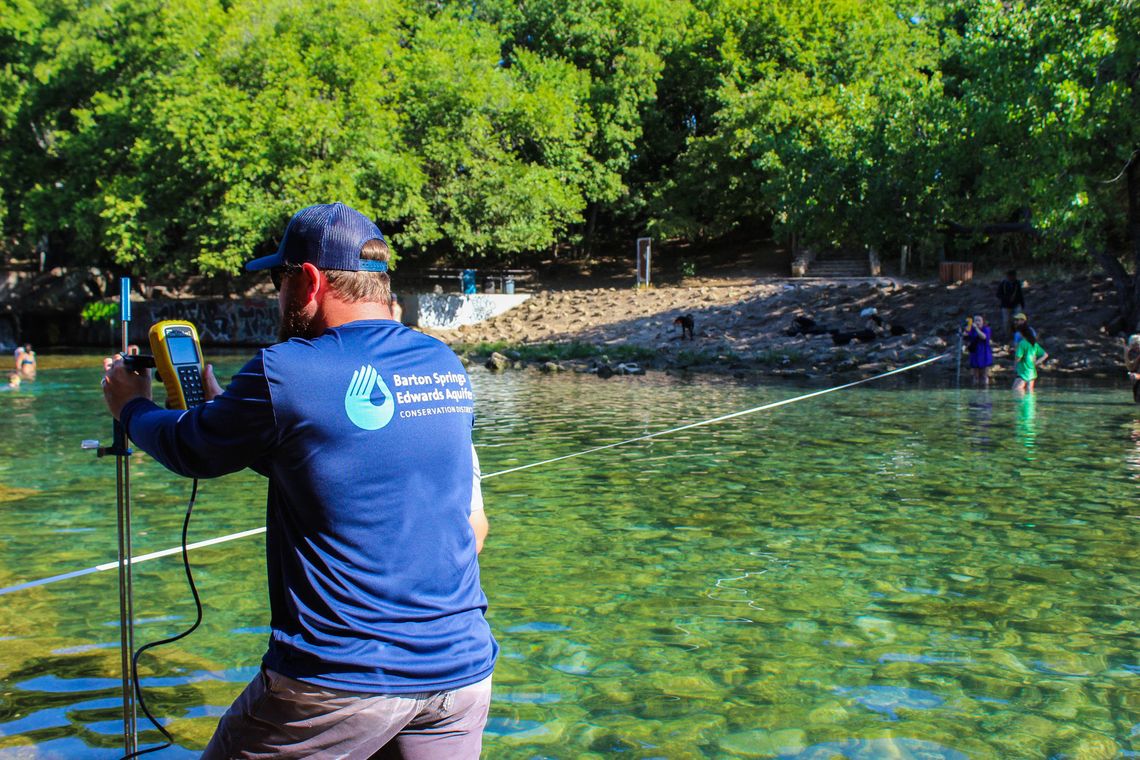HAYS COUNTY — The Barton Springs Edwards Aquifer Conservation District (BSEACD) anticipates it will need to change from a Stage III to Stage IV drought status as there has been a downward trajectory in the flow of Barton Springs since 2022.
Contributed Graphic
Hydrograph shows the variation in Barton Springs’ flow.[/caption]
Barton Springs’ 10-day average flow fell to 16 cubic feet per second in July 2023, while the average flow for the springs since 1978 is 68 cubic feet per second, according to field measurements collected by BSEACD. This decline in discharge, according to BSEACD, is representative of the alarmingly low water levels of the Barton Springs segment of the Edwards Aquifer, which serves as a water source for more than 60,000 people from South Austin to Kyle and is overseen and managed by the district.
The only way for the aquifer to recharge and end the drought conditions is a long period of significant rainfall.
“It’s not just the amount of rainfall that matters, but the rate at which it falls. In other words, the intensity of rainfall, measured in inches per hour or day, determines how much is absorbed by soil, taken up by plants and applied to aquifer recharge versus how much runs off to the nearest creek or detention basis,” explained BSEACD General Manager Tim Loftus. “Summer rainfall in our area also tends to be very spotty. The amount of land coverage that receives rain, therefore, is another important variable that will impact aquifer recharge. We need many inches of rain, preferably spread out over many days to recharge aquifers and refill streams and rivers.”
On average, July is the driest month of the year and August is the fourth driest month of the year in the Austin area, according to Loftus. In 2022, the district’s coverage area was below average for rainfall and it’s behind this year as well.
“The district has been in drought for 13 months and counting. Water is more valuable than what we pay for it each month,” Loftus said.
With the forecast predicting triple digit temperatures and minimal rain chances for the foreseeable future, it’s imperative for people in the district to actively conserve water resources.
Loftus encouraged residents to do the following to be mindful of their water usage:
• Eliminate or cut back outdoor water use like lawn watering.
• Run only full loads in the dishwasher and washing machine.
• Those who live in a house built before 2012 should replace toilets with high-efficiency, WaterSense-labeled toilets.
• Capture rinse water for use on trees and other plants.
• Install cisterns to capture rainwater from rooftops (when it does rain) for outdoor watering use.
• Make sure to repair any faucets that leak or toilets that run.
Groundwater use should be limited for indoor demands needed to preserve health and safety with a very minor allocation provided for nonessential outdoor purposes, according to BSEACD. End-user customers served by water utilities on groundwater wells, such as the cities of Buda and Kyle, are required to comply with their utility’s water use restrictions for any drought stage and should contact their service provider for additional information.
Visit or call 512-282-8441 to learn more.
Barton Springs Edwards Aquifer Conservation District forsees transitioning to Stage IV drought
— The Barton Springs Edwards Aquifer Conservation District (BSEACD) anticipates it will need to change from a Stage III to Stage IV drought status as there has been a downward trajectory in the flow of Barton Springs since 2022.
- 08/02/2023 09:50 PM











